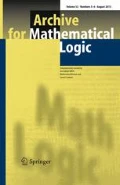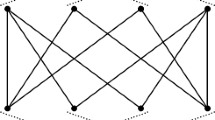Abstract
The first-order logical theory Th\(({\mathbb{N}},x + 1,F(x))\) is proved to be complete for the class ATIME-ALT\((2^{O(n)},O(n))\) when \(F(x) = 2^{x}\), and the same result holds for \(F(x) = c^{x}, x^{c} (c \in {\mathbb{N}}, c \ge 2)\), and F(x) = tower of x powers of two. The difficult part is the upper bound, which is obtained by using a bounded Ehrenfeucht–Fraïssé game.
Similar content being viewed by others
References
Balcázar J.L., Díaz J., Gabarró J. (1990). Structural Complexity II. Springer, Berlin
Berman L. (1980). The complexity of logical theories. Theoret. Comput. Sci. 11: 71–77
Compton, K.J., Henson, C.W.: A uniform method for proving lower bounds on the computational complexity of logical theories. Ann. Pure Appl. Logic 48, 1–79 (1990) [Updated version in: Abramsky, S. et al. (eds.) Handbook of Logic and Computer Science, Vol. 5: Logic and Algebraic Methods, pp. 129–216. Oxford University Press, Oxford (2000)]
Ehrenfeucht A. (1961). An application of games to the completeness problem for formalized theories. Fundam. Math. 49: 129–141
Elgot C.C., Rabin M.O. (1966). Decidability and undecidability of extensions of second (first) order theory of (generalized) successor. J. Symb. Logic 31: 169–181
Ferrante J., Rackoff C.W. (1979). The computational complexity of logical theories, Lecture Notes in Mathematics, vol. 718. Springer, Berlin
Fraïssé R. (1954). Sur quelques classifications des systèmes de relations. Université d’Alger, Publications Scientifiques, Séries A, 1: 35–182
Gaifman, H.: On local and nonlocal properties. In: Stern, J. (ed.) Logic Colloquium’81, pp. 105–135. North Holland, Amsterdam (1982)
Hua C.J. (1994). A new solution of the Diophantine equation X 2 + 1 = 2Y 4. J. Number Theory 48: 62–74
Korec I. (2001). A list of arithmetical structures complete with respect to the first-order definability. Theoret. Comput. Sci. 257: 115–151
Ljunggren : Zur Theorie der Gleichung X 2 + 1 = DY 4. Avh. Nordske Vid. Akad. Oslo 1, No. 5 (1942)
Lo L. (1988). On the computational complexity of the theory of abelian groups. Ann. Pure Appl. Logic 37: 205–248
Michel P. (1992). Complexity of logical theories involving coprimality. Theoret. Comput. Sci. 106: 221–241
Semenov, A.L.: Logical theories of one-place functions on the set of natural numbers. Math. USSR Izv. 22, 587–618 (1984) (Russian original: 1983)
Steiner R., Tzanakis N. (1991). Simplifying the solution of Ljunggren’s equation. J. Number Theory 37: 123–132
Thomas W. (1975). A note on undecidable extensions of monadic second order successor arithmetic. Arch. math. Logik 17: 43–44
Volger H. (1983). Turing machines with linear alternation, theories of bounded concatenation and the decision problem of first order theories. Theoret. Comput. Sci. 23: 333–337
Author information
Authors and Affiliations
Corresponding author
Rights and permissions
About this article
Cite this article
Michel, P. Computational complexity of logical theories of one successor and another unary function. Arch. Math. Logic 46, 123–148 (2007). https://doi.org/10.1007/s00153-006-0031-1
Received:
Published:
Issue Date:
DOI: https://doi.org/10.1007/s00153-006-0031-1



